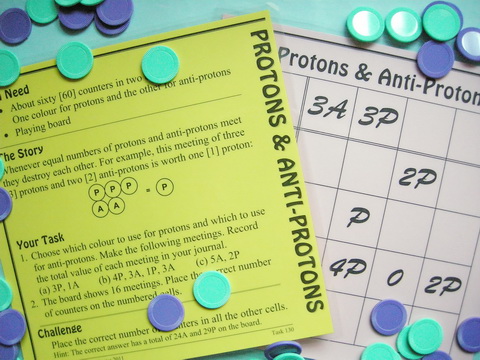
Protons & Anti-ProtonsTask 130 ... Years 4 - 10SummaryScientists do know that Protons and Anti-Protons exist. They also know that equal numbers of the two particles combine to have a total effect of zero. That is, a collection of (6P, 4A) would have an effect equivalent to 2P and a collection of (4P, 6A) would have an effect equivalent to 2A. This is a simplified representation of particle theory, but it is sufficient to support an investigation driven by the mathematician's questions:
|
Materials
Content
|

IcebergA task is the tip of a learning iceberg. There is always more to a task than is recorded on the card. |
After doing some practice calculations exploring what happens when collections of Protons and Anti-Protons meet, the students are challenged to fill in the gaps on the board. This exercise is self-correcting, given the check point on the card, however students may need some assistance if they don't get totals as shown. Discrepancies will be due to incorrect application of the zero rule and that usually arises in the case of subtracting a particle from a collection that has none of them. For example:
After considerable practice with problems like those on the card, teachers might ask students if they have heard about particles having a charge. Many do know that protons have a positive charge and electrons have a negative charge. It is a small step to consider that Protons could represent positive numbers and Anti-Protons (which are not electrons) represent negative numbers. Then a situation such as 3P - 2A could represent +3 - -2 and the answer would be +5. Being able to represent such integer arithmetic with objects or diagrams and calculate from first principles is a far cry from learning rules like 'minus subtract minus gives plus'. However, confidence and success do depend on the teacher not rushing into the symbolic representation of the Proton and Anti-Proton collections. Stick with concrete materials, diagrams and As and Ps for a considerable time. You can find a different model of integer arithmetic in Task 131, Walk The Plank. |
Note: This investigation has been included in Maths At Home. In this form it has fresh context and purpose and, in some cases, additional resources. Maths At Home activity plans encourage independent investigation through guided 'homework', or, for the teacher, can be an outline of a class investigation.
- Visit the Home Page for more Background.
- For this specific activity click the Learners link and on that page use Ctrl F (Cmd F on Mac) to search the task name.
Whole Class InvestigationTasks are an invitation for two students to work like a mathematician. Tasks can also be modified to become whole class investigations which model how a mathematician works. |
Poly Plug is an excellent tool for exploring Protons and Anti-Protons as a class. However, if you don't have access to this resource, other two-sided counters, or even pieces of torn paper marked with a cross on one side, will do the job. The whole class experience can begin by inviting a few students (say 10) to the front. They are split into two groups and one group is identified in some way as different. Perhaps they have their sleeves rolled up. Tell the story of how Protons and Anti-Protons behave and ask students to act out the creation of different collections. Then ask:
For more ideas and discussion about this investigation, open a new browser tab (or page) and visit Maths300 Lesson 76, Protons & Anti-Protons, which includes a scientific report about Protons and Anti-Protons, an Investigation Guide and companion software. Visit Protons & Anti-Protons in Poly Plug & Tasks. |
Is it in Maths With Attitude?Maths With Attitude is a set of hands-on learning kits available from Years 3-10 which structure the use of tasks and whole class investigations into a week by week planner. |
The Protons & Anti-Protons task is an integral part of:
The Protons & Anti-Protons lesson is an integral part of:
|